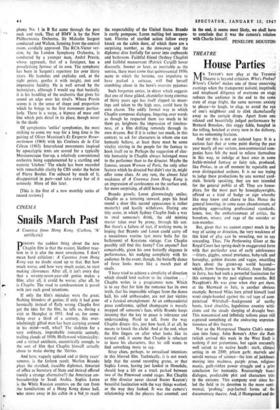CINEMA
Snails March Past
pERHAPS the saddest thing about the new Chaplin film is that the easiest, likeliest reac- tion to it is also the most unwelcome. I don't mean hard criticism: A Countess from Hong Kong can no doubt stand up to that. But how much worse, and how very much easier, to start making allowances. After all, it isn't every day that a seventy-seven-year-old genius makes a film; after all, it could be worse; after all, he is Chaplin. The road to condescension is paved with just such good intentions.
If only the film's mistakes were the great, flashing blunders of genius; if only it had gone heroically instead of flatly wrong. Chaplin first got the idea for the film, he tells us, during a visit to Shanghai in 1931. And so, for some- thing over a third of a century, this over- whelmingly gifted man has been carrying around in his mind—well, what? The skeleton for a very ordinary, improbable romantic comedy, trailing clouds of 1930s Hollywood whimsicality; and a virtual antithesis, eccentrically enough, to the sort of film that Chaplin himself actually chose to make during the 'thirties.
And here, vaguely updated and at thirty years' remove, is the forlorn result. Marlon Brando plays the starched, irascible diplomat, thwarted of office as Secretary of State and instead offered (surely a strange alternative?) the American am- bassadorship to Saudi Arabia. Sophia Loren is the White Russian countess on the run from the humiliations of a Hong Kong dance hall, who stows away in his cabin in a bid to reach the respectability of the United States. Brando is curtly pompous; Loren melting but unrepen- tant. Flurries of startled action follow every knock on the cabin door, of which there are a surprising number, as the stowaway and the diplomat dive fretfully for cover into cupboards and bathroom. Faithful friend (Sydney Chaplin) and faithful manservant (Patrick Cargill) hover discreetly. Sooner or later, as inevitable as the sunrise, there must come that quintessential 1930s scene in which the heroine, too impulsive to have packed a suitcase, will find herself stumbling about in the hero's oversize pyjamas.
Such forgotten antics, in decor which suggests that one of those gilded, chandelier-hung cinemas of thirty years ago has itself slipped its moor- ings and taken to the high seas, could have its own charm. The oddly formal way in which Chaplin composes dialogue, lingering over words as though he respected them too much to let them go, heightens the impression of timeless- ness, of a film drifting remotely through its own dreams. But if it is rather too much, in this context, to ask for characters in whom one can humanly believe, at least there must be some vitality stirring in the people for the fantasy to hook itself on to. Perhaps the suggestion of elec- tric humanity in Chaplin always belonged more to the performer than to the director. Maybe the famous, unseen Woman of Paris, the only other feature which he directed but didn't star in, might offer some clues. At any rate, the almost fatal weakness of A Countess from Hong Kong is an impression of carelessness on the surface and, far more surprising, of chill beneath it.
Brando growls; Loren glimmeringly smiles; Chaplin as a tottering steward, pops his head round a door (his second appearance is rather masterly) and hastily withdraws. During one tiny scene, in which Sydney Chaplin finds a way to steal someone's drink, the old miming master takes over by proxy, through his son. But there's a failure of tact, if nothing more, in hoping that Brando and Loren could carry off a seasickness routine (yet more bolts for the bathroom) of Keystone vintage. Can Chaplin possibly still find this funny? Can anyone? Just conceivably, given his own butterfly elegance in performance, his nudging complicity with his audience. In the event, though, the butterfly dance of farce looks more like a march past of snails.
`I have tried to achieve a simplicity of direction which should lend realism to the situation . . Chaplin writes in a programme note. Which is to say that for him the romance has its own truth, that his impossible refugee from the dance hall, his odd ambassador, are not just victims of a farcical entanglement. At an ambassadorial press conference, spilled champagne is messily mopped off someone's face, while Brando keeps intoning that the key to peace is tolerance and understanding. Hard to tell, from the way Chaplin directs this, just how hard, if at all, he means to knock the clichd. And at the end, when the film lingers on after what looks like its natural end, it seems that Chaplin is reluctant to leave his characters, that he still wants to find something more to say.
Stray clues, perhaps, to unrealised intentions in this blurred film. Technically, it is not much help that the sound recording grates, or that Sophia Loren, having just landed in Honolulu, should hop a lift on a truck parked between two of the Pinewood sound stages. But Chaplin as film director never shared Buster Keaton's beautiful fascination with the way things worked, or the way they looked. It was the camera's relationship with the players that counted; and
in the end, it seems most likely, we shall have to conclude that it was the camera's relation with Charlie himself. PENELOPE HOUSTON






























 Previous page
Previous page